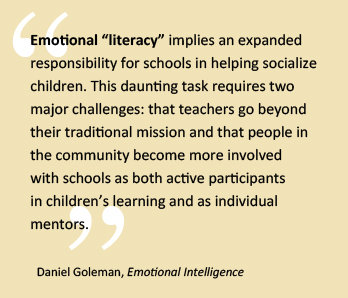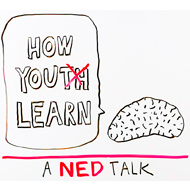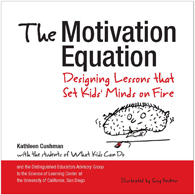

How Youth Learn: A Portfolio to Inform and Inspire Educators, Students, Parents & More
| Social and Emotional Learning : Research Highlights | SHARE | |
| SEE ALSO: Conditions of Learning | Mind, Brain & Education | Teenage Brain | Adolescent Development | Mindsets | Motivation & Mastery |
|
|
|
Perhaps it’s time to regard noncognitive dimensions as integral to thinking and learning, Conley says.
Are we not observing a higher form of thinking when we see students persist with difficult tasks, such as overcoming frustration; setting and achieving goals; seeking help; working with others; and developing, managing, and perceiving their sense of self-efficacy? Are these qualities not at least as important as knowing how well students recall information about the year in which the Civil War began, or how to factor a polynomial? Might what we observe when we look for noncognitive factors be a more complex form of cognition—a result of executive functioning by the brain as it monitors and adjusts to circumstances to accomplish specific aims and objectives?
A mounting body of research affirms what Conley suggests: the vital mutuality of academic, social, and emotional learning. Indeed, for researchers and educators who value social and emotional learning (or SEL), the noncognitive label has always been a misnomer. Before highlighting the research tied to SEL—which is just gathering steam—let us chart some of the influential frameworks in this burgeoning field.
Core social and emotional competencies
The Collaborative for Academic, Social and Emotional Learning (CASEL) at the University of Illinois-Chicago, identifies five interrelated sets of cognitive, affective, and behavioral competencies that evidence suggests contribute to student growth and mastery. CASEL believes these competencies can and should be taught to all students, K through 12. Daniel Goleman’s landmark book Emotional Intelligence provides the theoretical foundation.
- Self-awareness: The ability to accurately assess one’s feelings, interests, values, and strengths and to maintain a well-grounded sense of self-confidence.
- Self-management: The ability to regulate one’s emotions to handle stress, control impulses, and persevere in overcoming obstacles; to set and monitor progress toward personal and academic goals; and to express emotions appropriately.
- Social awareness: The ability to take the perspective of and empathize with others from diverse backgrounds and cultures; to understand social and ethical norms for behavior; and to recognize family, school, and community resources and supports.
- Relationship skills: The ability to build strong relationships with diverse individuals and groups—communicating clearly, listening actively, cooperating, resisting inappropriate social pressure, negotiating conflict constructively, and seeking and offering help when needed.
- Responsible decision-making: The ability to make constructive and respectful choices about personal behavior—taking into consideration ethical standards, safety concerns, social norms, the realistic evaluation of consequences of various actions, and the well-being of self and others.
Character
In 1992, the nonprofit Josephson Institute of Ethics hosted a gathering of experts in ethics and character education to find ways to work together, primarily by developing a common language of core ethical values that transcend religious, political and socioeconomic differences. The Aspen Declaration on Character Education identified six “pillars of character”: trustworthiness, respect, responsibility, fairness, caring, and citizenship.
The current interest in character education recognizes these virtues but also aims to untwine and promote a web of skills and habits linked to achievement.
Journalist Paul Tough’s popular book How Children Succeed, for example, argues that the “hidden power” of character influences why some children succeed while others fail. He focuses on skills like persistence, self-control, curiosity, conscientiousness, grit, and self-confidence—and on the particular experiences of children at either end of the socioeconomic ladder. Tough maintains that character skills like these arise from encountering and overcoming failure. He illuminates the extremes of American childhood: “for rich kids, a safety net drawn so tight it’s a harness; for poor kids, almost nothing to break their fall” (New York Times, August 23, 2012).
The “character education movement”—and the Character Education Partnership, a national advocacy group—draws energy from a wide swath of initiatives, from moral education and service learning to school safety. “Character education is simply good education,” the Character Education Partnership argues. “It helps solve behavioral problems and improve academic achievement.”
Positive discipline
The business of managing disruptive behavior, in and outside classrooms, has vexed educators for centuries. Today’s apparent rise in school violence and bullying, coupled with zero-tolerance policies, has moved disruptive student behavior to center stage.
However, suspending and expelling students for such reasons does more harm than good, the research increasingly suggests (e.g., American Academy of Pediatrics, Policy Statement, 2013). At worst, it produces what some call the “school to prison pipeline” (e.g., Teaching Tolerance, 2013).
“Positive discipline” invokes a non-punitive approach. At the school level it addresses conflict resolution creatively through practices like peer mediation, peer juries, peace circles, and restorative justice. At the classroom level, strategies like the “Guided Discipline” program developed by Educators for Social Responsibility, help teachers organize and manage their classrooms in ways that increase students’ learning and cooperation, self-management, responsible decision making, and disciplined work habits.
The benefits of social and emotional learning
The large plurality of definitions and frameworks linked to social and emotional learning pose formidable obstacles to assessing SEL’s benefits. Which “interventions” (to use the language of research) hold promise and by what measures?
Some answers appear in a recent meta-analysis of 213 positive youth development, SEL, character education, and prevention interventions, by Joseph Durlak et al. (2011). It reaffirms the following earlier findings from an array of discrete studies, summarized in several academic briefs prepared by CASEL.
- Student attachment to school is strongly influenced by the learning environment. Interventions that make the learning environment safer, more caring, and more participatory and that enhance students’ social competence have been shown to increase student attachment to school. In turn, students who are more engaged and attached to school have better attendance and higher graduation rates, as well as higher grades and standardized tests scores (e.g., Bryk & Schneider, 2002; Osterman, 2000).
- Interventions that improve classroom climate and functioning and enhance student attachment to school decrease rates of high-risk behaviors. When students are attached to school and to prosocial teachers and peers, they are more likely to behave in prosocial ways themselves (e.g, Wilson et al., 2001; Battistich et al., 2000).
- High-risk behaviors in students are associated with poor academic performance. Likewise, poor academic performance is a risk factor for a variety of high-risk behaviors, while academic achievement is a protective factor (e.g., Blum et al., 2000; Maguin & Loeber, 1996).
- Creating more caring and psychologically safe classroom environments also improves students’ social and emotional skills. In supportive atmospheres, for example, students feel more comfortable approaching and interacting with teachers and peers, thereby strengthening their relationship skills and their ability to successfully navigate the social learning environment of the classroom (e.g., Zins et al., Rimm-Kaufman, 2006; Johnson & Johnson, 1999).
- Incorporating cooperative learning techniques in the classroom enhances the quality of student learning and academic performance when compared to individualized learning. However, unless the students have good social and emotional skills— knowing how to manage and appropriately express emotions, solve problems, address conflicts, and understand the perspectives of others—the academic benefits of cooperative learning groups can be minimized or even negated (e.g., Munro et al., 2006; Johnson et al., 2000; Solomon et al., 1988).
- By providing students with good decision-making and refusal skills, SEL instruction encourages students to participate in behaviors that support their positive development (e.g., Linares et al., 2005; Wilson et al., 2001).
In How Children Succeed, Paul Tough pairs his stories of individual students, teachers, and principals with the stories and research of psychologists determined to unravel the dynamics of persistence, curiosity, self-confidence, and more. He introduces us, for example, to Angela Duckworth’s work on grit and self-control; Martin Seligman’s investigations of optimism; Gabrielle Oettingen’s research on self-regulation and goal setting; Madeline Levin’s findings on the specific psychological challenges of children raised in affluence; and Claude Steele’s studies on stereotype threat.




